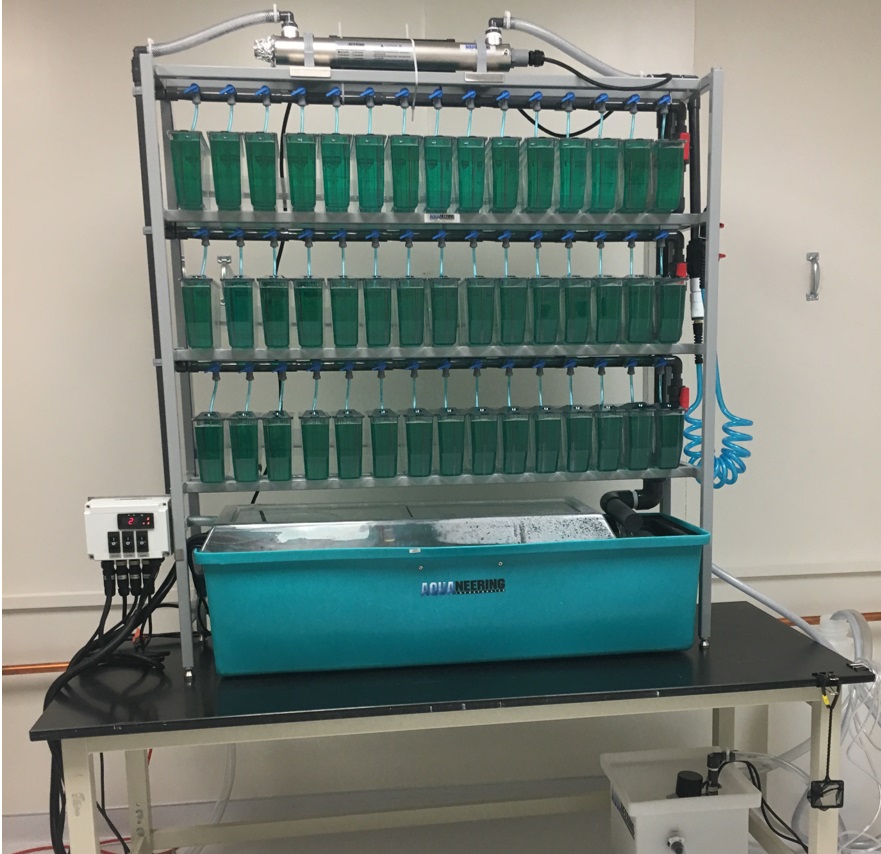 The new Zebrafish aquarium in our lab at ALS TDI
The new Zebrafish aquarium in our lab at ALS TDI
When walking through a drug development laboratory, one of the last things you might expect to see is an aquarium. But if you were to see our animal care facility today, you would find a series of tanks containing hundreds of zebrafish - a small, gray freshwater fish that’s part of the minnow family.
These fish are the newest model that we are utilizing in our research to find treatments for ALS. In this case a “model” simply means a cell or animal that has been developed or bred to have some aspects of a disease, so that they can be used to test possible treatments for that condition.
These models are an essential part of drug development. At the ALS Therapy Development Institute (ALS TDI), we rely on models to test if the drugs we’re working on are effective – and if they’re safe for a living organism – before considering them for possible trials in humans. We are always working to develop new models of the disease. It’s especially important for us as a lab that researches ALS ¬– a disease with many different causes – to develop multiple models that express the disease differently and can be tested in different ways. This led our team to establish a different model of ALS – zebrafish.
This project is the result of a long, challenging effort by ALS TDI scientists, led by scientist Val Tassinari, in collaboration with Tennore Ramesh of the University of Sheffield. At this time, we have just begun to receive shipments of the fish that will be used as experimental models of ALS, but Val has been hard at work for over a year using healthy zebrafish to create a safe and clean environment for the fish to live. With help from other scientists in the lab, she built a series of aquarium tanks and established a breeding program to make sure we will eventually have a steady supply of adult fish, larvae, and embryos for testing.
Zebrafish have many advantages as a model for ALS. First, they can serve as an intermediary step between tests in cells and tests in mice. In our normal process, compounds are tested in individual cells to identify those that show promise as ALS treatments. Those that show efficacy are then are moved on to testing in mice. Cell-based tests can be done quickly in large numbers, but testing in mice takes months.
Zebrafish can serve as a “happy-medium” between these two stages of testing. They are small but still biologically complex – a zebrafish larva with a fully functioning brain, liver, and heart is only around 5 millimeters long. They can therefore be used to test many more compounds much faster than in mice, but still yield valuable information about how a drug performs in a multicellular, living organism. While mouse models are still essential to this process – it’s very important to make sure these drugs are effective and safe in a larger mammal more biologically similar to humans – zebrafish can serve to weed out more ineffective or harmful drugs before they reach the mouse testing phase of preclinical development. This could be very valuable in reducing the amount of time spent testing ineffective or unsafe drugs in the much slower mouse model.
The zebrafish model also serves a need that mice haven’t been able to fill yet – the ability to be used as a model of the C9orf72 mutation. Research has shown that a mutation of the C9orf72 may be present in as many as 40% of cases of familial ALS. However, despite years of effort, no one has been able to develop and breed a testable model of this kind of mutation – mice bred with a mutated C9orf72 gene seem to not show any symptoms of ALS. However, experiments have shown that zebrafish bred with this mutation are symptomatic – and thus could serve as a model for testing drugs targeting C9orf72 ALS. One of the most important next steps will be “characterizing,” or establishing baselines around how these fish express and progress through the symptoms of ALS throughout their lifespan, and beginning to investigate how promising drug candidates might affect those symptoms.